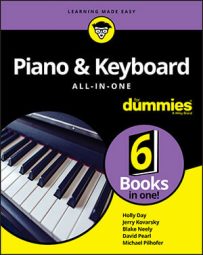This common keyboard sound tweak is sometimes just a small adjustment to darken or brighten a sound; that can be all you need to go from “not quite” to “perfect.” For example, this edit is the first thing many players like to do to acoustic piano sounds. What sounds good playing alone at home doesn’t end up cutting through the sound of a full band when you play a gig.
So brighten up the sound a little! The easiest way to change the brightness one way or the other is to simply alter the level of the filter cutoff. If you don’t see a front-panel control labeled Filter or Filter Cutoff, do the following:
Go into the sound or program edit mode of your keyboard.
Find the filter parameters or page and locate the filter cutoff parameter.
Raise or lower the value to change the sound.
To darken the sound, lower the value; to brighten it, raise the value.
Save your new sound.
Be sure to give it a new name and save it to a different location so that you don’t lose your first sound!
Many keyboards have a front panel knob dedicated to controlling the filter cutoff as you play, which means you don’t have to go into edit mode to sweep the cutoff (a popular thing to do). Some synths have a ribbon controller with the filter cutoff assigned to it. And many small performance synths that don’t have this dedicated knob assign filter cutoff to the mod wheel for easy filter sweeps.
You may not be able to darken the sound by this simple edit if the sound is using an envelope generator to vary the filter cutoff over time. An easy clue you’re in this scenario: The filter cutoff is very low, yet you still find the sound is bright.
In this case, you need to lessen the effect the envelope has on the attack section of the shape in order to darken the filter. Look for the envelope depth parameter (it may be called Filter EG) or for an envelope being used as a modulator assigned to filter cutoff and lower the modulation amount.
If your keyboard doesn’t have a Filter EG parameter but has the more advanced rate and level envelope generator, lower the attack level value. Doing so causes the envelope to not go as high before moving to the decay stage, which darkens your sound.
Finally, some sounds use velocity to modulate the filter cutoff or how much the filter EG affects the cutoff. When you play this type of sound, a very soft touch produces a dark sound, and harder hits produce a brighter sound. If you reduce the velocity control over the filter EG or velocity modulation amount routed to the filter cutoff, you can darken the sound.
Yes, it will still get brighter the harder you play, but not as bright. (Note that the softer touch will now be even darker, but often that difference isn’t an issue. If it does bother you, raise the filter cutoff just a few numbers.)
Don’t forget that EQ is also a type of filter control; you can lower the high EQ level to darken your sound some and raise it to brighten it.

